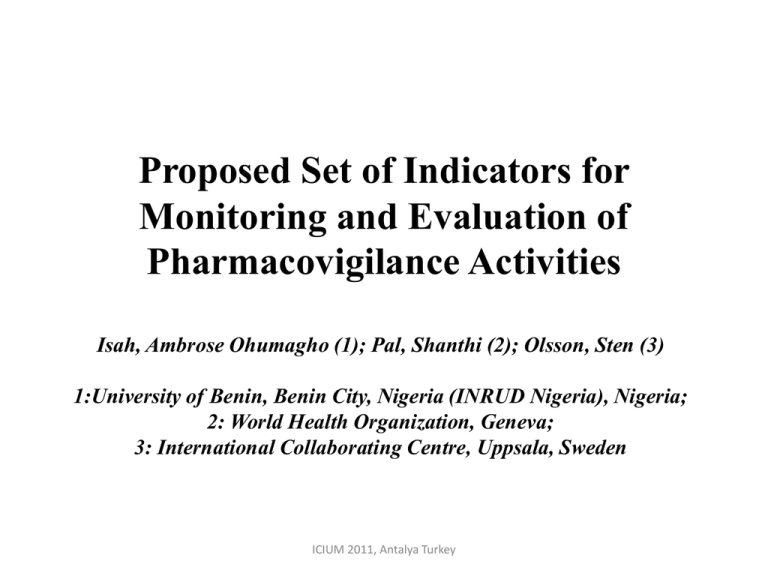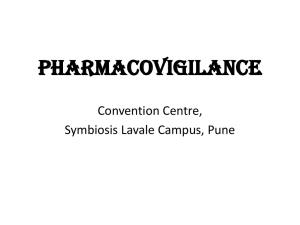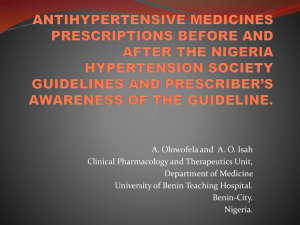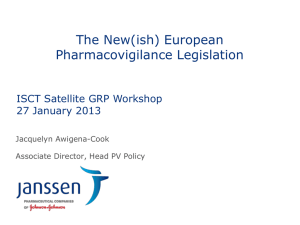1033-ISAH-_b
advertisement

Proposed Set of Indicators for Monitoring and Evaluation of Pharmacovigilance Activities Isah, Ambrose Ohumagho (1); Pal, Shanthi (2); Olsson, Sten (3) 1:University of Benin, Benin City, Nigeria (INRUD Nigeria), Nigeria; 2: World Health Organization, Geneva; 3: International Collaborating Centre, Uppsala, Sweden ICIUM 2011, Antalya Turkey Proposed Set of Indicators for Monitoring and Evaluation of Pharmacovigilance Activities Isah, Ambrose Ohumagho (1); Pal, Shanthi (2); Olsson, Sten (3) ambroseisah@yahoo.com 1: University of Benin, Benin City, Nigeria (INRUD Nigeria), Nigeria; 2: World Health Organization, Geneva; 3: International Collaborating Centre, Uppsala, Sweden Problem Statement: The thalidomide tragedy triggered global consciousness regarding the safety of medicines. The need to monitor safety issues regarding the intake of medicines has resulted in the tremendous growth of pharmacovigilance (PV) structures and activities. However, there are no acceptable standard set of indicators to measure and monitor these activities. Furthermore, there are no indices for comparison of measures in relation to baseline periods or inter- and intracountry, region, and facility comparisons. Objectives: To outline a set of indicators for monitoring PV activities Design: A qualitative study with the identification of a set of candidate indicators. Setting: The envisaged setting for use will include country, regional, health facilities and public health programmes. Methods: The set of indicators were identified from several sources— initially from a detailed review of the established pharmacovigilance process/routine, contributions from pharmacovigilance experts, national pharmacovigilance centres, and groups including Pharmacovigilance sans Frontiers (PVSF), the World Health Organization (WHO) Advisory Committee on Safety of Medicinal Products (ACSoMP), WHO-Uppsala Medical Centre, and literature sources. Results: A total of 64 candidate indicators were identified. The indicators were categorized into structural (19) which assesses the existence of key PV structures, systems, and mechanisms in the setting; process (26) which assesses the entire mechanisms and degree of PV activities; and outcome/impact (19) which measures the effects (results and changes) of PV activities indicators . A set of background information (10) to put into perspective the PV milieu (demographics, economics, health care system, and pharmaceutical scenario) generating the indicator data was also noted. This will also serve to provide the denominator for measuring the indicators. A further categorization into Core and Complementary were made. A further subset for use in public health programmes is also highlighted Conclusions: The set of indicators provide a useful robust tool to monitor and evaluate PV activities at various levels of the healthcare system as well as to provide indices for comparison of PV activities at country, regional, and facility levels, and within public health programmes. Funding: WHO ICIUM 2011, Antalya Turkey Introduction • The thalidomide tragedy kindled global consciousness regarding the need to monitor the safety of medicines • The erection of Pharmacovigilance (PV ) systems from the initial steps of ADR reporting has resulted in the tremendous growth of structures and activities. • There are no acceptable standard set of indicators to measure and monitor these activities. • Furthermore, there are no indices for comparison of measures in relation to baseline periods or inter- and intra-country, region, and facility comparisons. ICIUM 2011, Antalya Turkey Objectives Broad Objective • To provide objective measures which will enable the assessment of the status of Pharmacovigilance, the activities and its impact, globally at all levels of the healthcare system, with a view to ensuring patient safety. Specific Objectives • To outline a set of indicators for monitoring and evaluating PV activities • To provide a tool for measuring changes in the Pharmacovigilance System as well as the impact of PV intervention ICIUM 2011, Antalya Turkey Methods The set of candidate indicators were identified and revised from several sources: • Initially from a detailed review of the established pharmacovigilance systems - processes/routines and literature sources. • Contributions from Pharmacovigilance Experts affiliated to the following – National Pharmacovigilance Centres (+ Survey) – Pharmacovigilance sans Frontiers (PVSF) – WHO Advisory Committee on Safety of Medicinal Products (ACSoMP) – ( + Validation) – WHO-Uppsala Monitoring Centre ICIUM 2011, Antalya Turkey Pharmacovigilance Indicators Framework Structural (19) Outcome/Impact (19) Assesses key PV structures, systems and mechanisms (qualitative) Process (26) Assesses the degree of PV activities Measures the effects (results and changes) of PV activities Core (9) • Core (9) • Core (9) • Complementary • Complementary Complementary BACKGROUND INFORMATION (10) ICIUM 2011, Antalya Turkey Provides information on PV millieu Pharmacovigilance Indicators CORE Indicators considered to be highly relevant, important and useful in characterizing PV. They should be stated in most instances where comparative PV indices are required. COMPLEMENTARY Other useful indicators which serve to further characterize the pharmacovigilance situation in the stated setting but need not be used in all instances. INDICATORS: STRUCTURAL PROCESS OUTCOME/IMPACT BACKGROUND INFORMATION ICIU11, Antalya Turkey Core Structural Indicators 1. Is there a Pharmacovigilance (PV)Centre/Department/Unit with a standard accommodation? YesNo 2. Is there a statutory provision (national policy, legislation) on PV? YesNo 3. Is there a Drug Regulatory Authority/Agency? YesNo 4. Is there any financial arrangement (statutory budget) for the PV centre? YesNo 5. Is the personnel (Full time equivalents) disposition in the PV centre adequate? YesNo 6. Is there a case management system in place? YesNo 7. Is there a standard ADR reporting form containing the essential elements in the setting? YesNo 8. Percentage of registered manufacturing industries with a functional Pharmacovigilance unit? YesNo 9. Is PV incorporated into the curriculum of the various health care professionals? Doctors Yes No; Dentists Yes No ; PharmacistsYes No; Nurses Yes No Others(specify______) ICIUM 2011, AntalyaYes Turkey No Core Process Indicators 1. Total number of ADR reports received in the last year? (also express as no. per 100,000 persons in population) 2. Total number of reports in the national/regional/local database 3. Percentage of total annual reports issued informative feedback 4. Percentage of total reports subjected to causality assessment in the year 5. Percentage of total annual reports satisfactorily completed and submitted to the National Centre / committed to UMC. 6. Percentage of medicines that are counterfeit/substandard in the pharmaceutical market 7. Number of total medication errors reported in the year? 8. What proportion of pharmaceutical industries have a functional PV system 9. Average number of reports per pharmaceutical industry per year ICIUM 2011, Antalya Turkey ____ (_) ____ ____ ____ ____ ____ ____ ____ ____ Core Outcome/Impact Indicators 1. No. of signals generated in last 5 years 2. Number of medicine -related hospital admissions per 1,000 admissions 3. Number of medicine- related deaths per 100,000 persons in the population 4. Medicines -related deaths per 1,000 persons admitted into hospital (annual) 5. Number of regulatory actions taken in the preceding year consequent on pharmacovigilance activities? – Label changes (variation) – Safety warnings – Drug withdrawals 6. Average cost of treatment of medicines related illness 7. Mean duration of medicines-related hospital stay 8. Average cost incurred for medicines - related hospitalization 9. Average Work/School days lost due to drug related problems ICIUM 2011, Antalya Turkey _____ _____ _____ _____ _____ _____ _____ _____ _____ _____ _____ Pharmacovigilance Indicators for Public Health Programmes 1. Is there a Pharmacovigilance system in place? 2. Is there a standard ADR reporting form containing the essential elements ADRs in the setting? 3. Total number of Adverse reports in the database 4. Total number of reports per 1000 patients/population exposed to medicine 5. Total number of lack of efficacy reports in database 6. Total number of substandard/ counterfeit medicine reports in database 7. Percentage of satisfactorily completed reports submitted to the National Centre 8. Percentage of reporters issued informative feedback 9. Number of medicine - related hospital admissions per 1,000 admissions 10. Number of medicine - related deaths per 1,000 persons admitted into hospital (annual)ICIUM 2011, Antalya Turkey Yes No Yes No ______ ______ ______ ______ ______ ______ ______ ______ CONCLUSION/IMPLICATIONS • The set of indicators provide a useful, simple, robust tool to monitor and evaluate PV activities at various levels of the healthcare system. • They also serve as indices for comparison of PV activities at country, regional, and facility levels, and within public health programmes. • The availability of these indicators will enable monitoring of the impact of policy provisions and interventions in the pharmacovigilance system ICIUM 2011, Antalya Turkey








